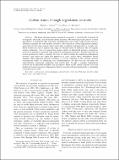| dc.contributor.author | Forney, David C. | |
| dc.contributor.author | Rothman, Daniel H. | |
| dc.date.accessioned | 2015-07-29T12:36:24Z | |
| dc.date.available | 2015-07-29T12:36:24Z | |
| dc.date.issued | 2014-02 | |
| dc.date.submitted | 2013-05 | |
| dc.identifier.issn | 0012-9615 | |
| dc.identifier.uri | http://hdl.handle.net/1721.1/97915 | |
| dc.description.abstract | The decay of organic matter in natural ecosystems is controlled by a network of biologically, physically, and chemically driven processes. Decomposing organic matter is often described as a continuum that transforms and degrades over a wide range of rates, but it is difficult to quantify this heterogeneity in models. Most models of carbon degradation consider a network of only a few organic matter states that transform homogeneously at a single rate. These models may fail to capture the range of residence times of carbon in the soil organic matter continuum. Here we assume that organic matter is distributed among a continuous network of states that transform with stochastic, heterogeneous kinetics. We pose and solve an inverse problem in order to identify the rates of carbon exiting the underlying degradation network (exit rates) and apply this approach to plant matter decay throughout North America. This approach provides estimates of carbon retention in the network without knowing the details of underlying state transformations. We find that the exit rates are approximately lognormal, suggesting that carbon flow through a complex degradation network can be described with just a few parameters. These results indicate that the serial and feedback processes in natural degradation networks can be well approximated by a continuum of parallel decay rates. | en_US |
| dc.description.sponsorship | National Science Foundation (U.S.) (Grant EAR-0420592) | en_US |
| dc.description.sponsorship | United States. National Aeronautics and Space Administration (Grant NNA08CN84A) | en_US |
| dc.language.iso | en_US | |
| dc.publisher | Ecological Society of America | en_US |
| dc.relation.isversionof | http://dx.doi.org/10.1890/12-1846.1 | en_US |
| dc.rights | Article is made available in accordance with the publisher's policy and may be subject to US copyright law. Please refer to the publisher's site for terms of use. | en_US |
| dc.source | Ecological Society of America | en_US |
| dc.title | Carbon transit through degradation networks | en_US |
| dc.type | Article | en_US |
| dc.identifier.citation | Forney, David C., and Daniel H. Rothman. “Carbon Transit through Degradation Networks.” Ecological Monographs 84, no. 1 (February 2014): 109–129. © 2014 Ecological Society of America | en_US |
| dc.contributor.department | Massachusetts Institute of Technology. Department of Earth, Atmospheric, and Planetary Sciences | en_US |
| dc.contributor.department | Massachusetts Institute of Technology. Department of Mechanical Engineering | en_US |
| dc.contributor.department | Lorenz Center (Massachusetts Institute of Technology) | en_US |
| dc.contributor.mitauthor | Forney, David C. | en_US |
| dc.contributor.mitauthor | Rothman, Daniel H. | en_US |
| dc.relation.journal | Ecological Monographs | en_US |
| dc.eprint.version | Final published version | en_US |
| dc.type.uri | http://purl.org/eprint/type/JournalArticle | en_US |
| eprint.status | http://purl.org/eprint/status/PeerReviewed | en_US |
| dspace.orderedauthors | Forney, David C.; Rothman, Daniel H. | en_US |
| dc.identifier.orcid | https://orcid.org/0000-0003-4006-7771 | |
| mit.license | PUBLISHER_POLICY | en_US |
| mit.metadata.status | Complete | |
